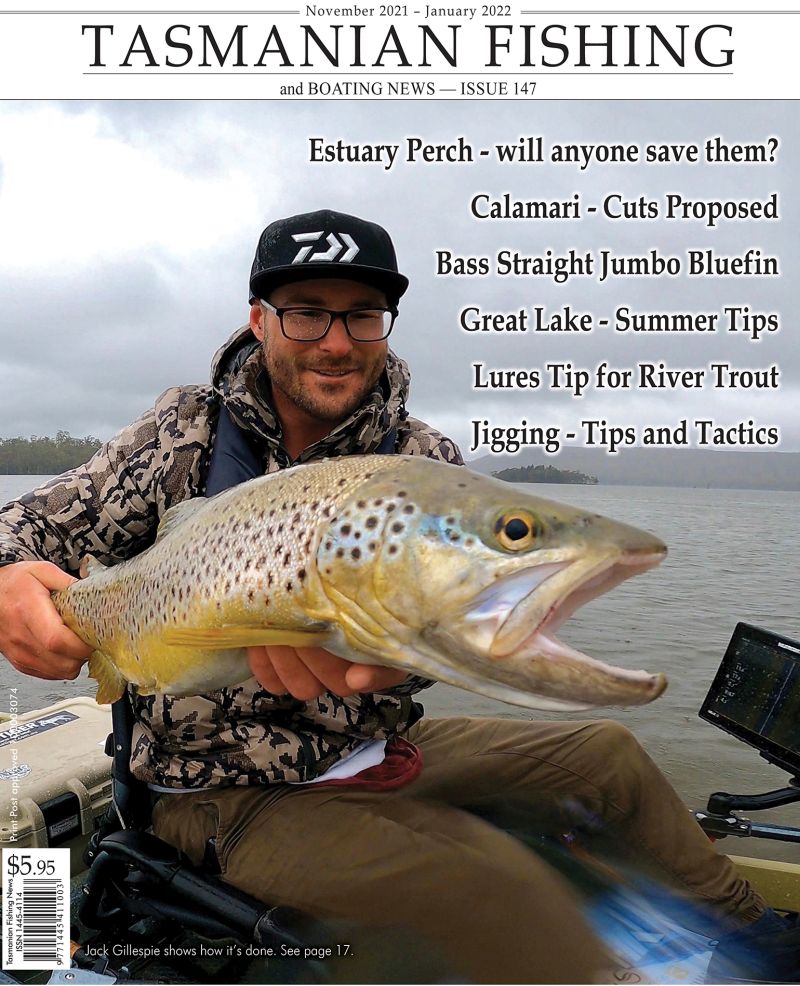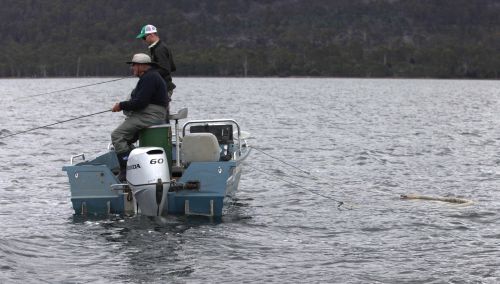From the Archives ...
Atlantic salmon the hard way
Atlantic salmon the hard way
Scott McDonald
The first Atlantic salmon eggs used to begin Tasmania's Atlantic salmon aquaculture industry were introduced into Tasmania in 1984. From these humble beginnings a valuable Tasmanian industry has evolved with a worldwide reputation for having a premium disease free product. This industry provides a spin off to all anglers in the form of regular escapes of salmon from the farms.
Please check all relevant authorities before fishing - www.ifs.tas.gov.au and dpipwe.tas.gov.au . Don't forget issuu.com/stevenspublishing for years of back issues !
4 St Helens
A great fishery all year round.
A few species that may be found include Australian salmon, flathead, garfish, albacore, yellowfin tuna, striped marlin and mako shark.
The township of St Helens is nestled on Georges Bay, a sheltered area of water situated a quarter of the way down Tasmania's East Coast. St Helens provides a large range of estuarine and offshore species. Relatively mild weather is experienced even over winter due to protection from the prevailing westerly winds. Five boat ramps service the area, three in Georges Bay, the other two giving direct ocean access via Binalong Bay and Burns Bay, eliminating the need to cross the St Helens barway.
- Written by Stephen Smith - Rubicon Web and Technology Training
- Category: Mike's Top 10 Spots
- Hits: 10828
3 Pirates Bay, Tasman Peninsula and Pedra Branca
The continental shelf is quite close to shore here, and with a vast topographic underwater terrain the game fishing can be nothing short of sensational. Very deep water is common close to shore and a lot of game fishers troll virtually along the bottom of the many spectacular cliffs in search of game fish. Water depths of over 100 metres are common close inshore.
- Written by Stephen Smith - Rubicon Web and Technology Training
- Category: Mike's Top 10 Spots
- Hits: 8832
Read more: Top 10 (03) Pirates Bay, Tasman Peninsula and Pedra Branca
2 Derwent River
Piersons Point - Iron Pot mark the lower limit of the Derwent Estuary and the transition to Storm Bay and the Tasman Sea. A good boat ramp at Tinderbox services this area and you should be aware of a Marine Reserve here that runs between Tinderbox and Bruny Island. Please refer here for relevant information, access and restrictions. Outside this there is excellent fishing for sand and tiger flathead, Australian salmon, couta (barracouta), plus longfin pike and occasionally good runs of squid. Warehou usually appear in the summer - autumn period and are known locally as snotties, or snotty trevally.
- Written by Stephen Smith - Rubicon Web and Technology Training
- Category: Mike's Top 10 Spots
- Hits: 16365
1 Tyenna River
The Tyenna, a tributary of the Derwent, starts at the back of Mount Field flowing in an easterly direction for some 40 kilometres before its confluence with the Derwent River above Bushy Park.
- Written by Stephen Smith - Rubicon Web and Technology Training
- Category: Mike's Top 10 Spots
- Hits: 13523
 Do you eat lobster mustard?
Do you eat lobster mustard?
If so the experts would like to talk to you!
In April the South Australian Research and Development Institute (SARDI) conducted an on-line survey on rock lobster (crayfish) consumption.
Analysis of the results has shown a very interesting difference in how lobsters are consumed between lobster fishing areas. In the Tasmanian Western Region, 21% of respondents stated they eat the mustard (the hepatopancreas or liver-like organ). In the Eastern Region, 15% consume the mustard. In South Australia, only 5% consume this part of the lobster (the picture above shows mustard being used as a sauce).
- Written by Stephen Smith - Rubicon Web and Technology Training
- Category: IFS, DPIPWE, MAST and Peak Bodies
- Hits: 8182
 Furneaux Biotoxin Zone to open Sunday 13 December 2015
Furneaux Biotoxin Zone to open Sunday 13 December 2015
Results of rock lobster taken from the Furneaux Biotoxin zone sampled on 7 December 2015 have returned biotoxin levels that will enable the fishery in that zone to open. The area to open is the Furneaux zone (north of the middle of Banks Strait) and that part of the eastern region in Bass Strait north of 40° 39’ 18” S. This area opens on Sunday, 13 December 2015 at 00.01 hrs to the taking of rock lobster. Pots may be set in the area from 13:00 hrs (i.e. 1 p.m.) Saturday, 12 December 2015; however, pots cannot be hauled or lobster taken until Sunday 00:01 hours (i.e. Sunday morning).
Status of remaining closed areas
- Written by Stephen Smith - Rubicon Web and Technology Training
- Category: IFS, DPIPWE, MAST and Peak Bodies
- Hits: 4519
Tasmania and Southern Australia to suffer even more from Super Trawler
The Stop the Trawler Alliance is alarmed that the Small Pelagic Fishing Industry Association is pushing the super trawler into southern Australia and claiming that they are reducing impacts on recreational fishers and marine life.
“The Industry decision to pause use of the super trawler in Zone 7 in northern NSW is designed purely to silence MP Bob Baldwin before the Federal Election without having an impact on their fishing operations. There has been community outrage and local MP Bob Baldwin has done the right thing and responded to this, however the industry doesn’t have a permit from the NSW Government for super trawlers to fish there anyway,” said Nobby Clark of Game Fish Tasmania Sports Fishing Club.
- Written by Stephen Smith - Rubicon Web and Technology Training
- Category: Super Trawler
- Hits: 4755
Read more: Tasmania and Southern Australia to suffer even more from Super Trawler.
 Fisheries Situation Update – 3 December 2015
Fisheries Situation Update – 3 December 2015
The status of the rock lobster Biotoxin Zones in the eastern region remains unchanged.
Laboratory analysis results for rock lobster samples collected from the Lower East Coast Zone (Tasman Peninsula) on Monday 30 November have shown that paralytic shellfish toxin (PST) remain at unacceptable levels.
Therefore, the Lower East Coast Zone will remain closed at this time. Further sampling of rock lobster from this area will be expedited with the aim of getting results prior to the weekend of 12/13 December.
The Lower East Coast Zone (Tasman Peninsula), Maria Island Zone, Upper East Zone (St Helens) and Furneaux Zone remain closed to rock lobster fishing - with no change of status likely before Sunday 13 December.
- Written by Stephen Smith - Rubicon Web and Technology Training
- Category: IFS, DPIPWE, MAST and Peak Bodies
- Hits: 4479
Fly In Fly Out Boating
Enjoy a day on the water with a boat for hire from http://www.tassieboathire.com.au/
This newly released video shows some of the great options for boat hire available from http://www.tassieboathire.com.au/
Have a look at the video at https://youtu.be/CgtlrWUniP8 and from the description at youtube:
In this episode of Starlo Gets Reel, Starlo and Jo head to the Central Highlands of Tasmania in pursuit of trout... and checkout the boat and trailer packages available from Tassie Boat Hire whilst they are there. If Tassie trout are on your radar, take the time to watch Starlo's wash-up and find out whether this product is as good as it sounds...
- Written by Stephen Smith - Rubicon Web and Technology Training
- Category: Trout Fishing
- Hits: 5262
 Rock lobster biotoxin sampling update - 1 December
Rock lobster biotoxin sampling update - 1 December
Biotoxin sampling yesterday saw a dive team from the Institute for Marine and Antarctic Studies collecting rock lobster from the Lower East Coast Zone (Tasman Peninsula). Toxin analysis is done in Sydney at the only certified Australian laboratory and takes several days. Results for these samples may be received either late this Friday or not until the following Monday. If the results return acceptable levels, the earliest possible status change for the Lower East Coast Zone is Sunday 6 December. Alternatively, if the levels are high, this area will remain closed.
Source : http://dpipwe.tas.gov.au/sea-fishing-aquaculture/sustainable-fisheries-management/Biotoxin-Fishery-Events
- Written by Stephen Smith - Rubicon Web and Technology Training
- Category: IFS, DPIPWE, MAST and Peak Bodies
- Hits: 5637
Read more: Rock lobster biotoxin sampling update - 1 December
Subcategories
Current TFBN
Click above for current issue content. The current issue of TFBN is extensive and topical. In Tackle Stores, Newsagents and by subscription.
Delivered to your door for $48 for 2 years (8 issues). To subscribe, send Mike $48 via www.paypal.com.au . (Basic instructions are here) The email is at Contact Us. Your address will be included from PayPal.
Or phone Mike with your c/c handy on 0418129949
Please ensure your details are correct, for Mike to organise delivery.
TFBN Newsletter Sign up Form
Why not submit an article ?
When you have finished for the day, why not have a brag about the ones that didn't get away! Send Mike an article on your fishing (Click here for contact details), and we'll get it published here. Have fun fishing - tasfish.com
Category Descriptions
Here is a list of all of the Article Categories. The number in Brackets, eg (13) is the number of articles. Click on Derwent River and all articles relating to the Derwent will be displayed in the central area.
Articles by Category
-
Rivers (3)
-
Saltwater and Estuary Fishing (149)
-
Kayak Fishing (34)
-
Lakes (1)
-
Great Lake (62)
-
Lake Leake (52)
-
Woods Lake (16)
-
Lake Augusta (11)
-
Huntsman Lake (13)
-
Lake Pedder and Gordon (10)
-
Lake Dulverton (5)
-
Lake Crescent (6)
-
Tooms Lake (10)
-
Lake Mackintosh (2)
-
Lake Barrington (5)
-
Little Lake (8)
-
Meadowbank Lake (5)
-
Lake King William (7)
-
Lake St Clair (2)
-
Western Lakes (12)
-
Arthurs Lake (35)
-
Lake Echo (7)
-
Four Springs (54)
-
Lake Sorell (7)
-
Lake Burbury (6)
-
Other Lakes (57)
-
Brushy Lagoon (18)
-
Little Pine Lagoon (5)
-
Penstock Lagoon (16)
-
Brumbys Creek (7)
-
-
Events (48)
-
Estuary Fishing (0)
-
Coastal Catches (46)
-
Super Trawler (46)
-
IFS, DPIPWE, MAST and Peak Bodies (435)
-
Commercial Interests (98)
-
Other (24)
-
TFBN Back Issues (8)
-
Fly Fishing (67)
-
Trout Fishing (252)
-
Meteorology and Weather (8)
-
Jan’s Flies (50)
-
Tuna Fishing and other Game Fishing (86)
-
Cooking Fish (19)
-
Fishing Information (1)
-
Fishing Books (8)
-
Videos (5)
-
Tackle, Boats and other Equipment (146)
-
World Fly Fishing Championship 2019 (2)
Popular Tags
windyty.com
Visit https://www.windyty.com/
Rubicon Web and Technology Training
Hello everyone, I thought it would be a good time to introduce myself.
My name is Stephen Smith and I have been managing the website tasfish.com since May 2009.
It has been an epic journey of learning and discovery and I am indebted to Mike Stevens for his help, support and patience.
I am developing a new venture Rubicon Web and Technology Training ( www.rwtt.com.au ). The focus is two part, to develop websites for individuals and small business and to train people to effectively use technology in their everyday lives.
Please contact me via www.rwtt.com.au/contact-me/ for further information - Stephen Smith.
From the Archives ... (last chance)
Trout tips - from tackle shops
Presented from Issue 105, August 2013
We did a bit of a runaround Tasmania’s tackle stores to see what their tips for the first month or so of the tackle season were. We asked what the top three places to fish were, plus lures, flies, baits and a few other things.
Here is a rundown on their answers Whenever, and wherever you fish - anywhere, or for any fish in the world - ask the locals and especially ask at the local tackle store. They know what was caught today, yesterday and on what.



